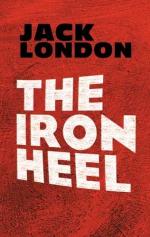“Still I don’t see,” I objected. “What is to become of the other unions? There are far more unions outside of this combination than in it.”
“The other unions will be ground out of existence—all of them. For, don’t you see, the railway men, machinists and engineers, iron and steel workers, do all of the vitally essential work in our machine civilization. Assured of their faithfulness, the Iron Heel can snap its fingers at all the rest of labor. Iron, steel, coal, machinery, and transportation constitute the backbone of the whole industrial fabric.”
“But coal?” I queried. “There are nearly a million coal miners.”
They are practically unskilled labor. They will not count. Their wages will go down and their hours will increase. They will be slaves like all the rest of us, and they will become about the most bestial of all of us. They will be compelled to work, just as the farmers are compelled to work now for the masters who robbed them of their land. And the same with all the other unions outside the combination. Watch them wobble and go to pieces, and their members become slaves driven to toil by empty stomachs and the law of the land.
“Do you know what will happen to Farley* and his strike-breakers? I’ll tell you. Strike-breaking as an occupation will cease. There won’t be any more strikes. In place of strikes will be slave revolts. Farley and his gang will be promoted to slave-driving. Oh, it won’t be called that; it will be called enforcing the law of the land that compels the laborers to work. It simply prolongs the fight, this treachery of the big unions. Heaven only knows now where and when the Revolution will triumph.”
* James Farley—a notorious strike-breaker of the period. A man more courageous than ethical, and of undeniable ability. He rose high under the rule of the Iron Heel and finally was translated into the oligarch class. He was assassinated in 1932 by Sarah Jenkins, whose husband, thirty years before, had been killed by Farley’s strike-breakers.
“But with such a powerful combination as the Oligarchy and the big unions, is there any reason to believe that the Revolution will ever triumph?” I queried. “May not the combination endure forever?”
He shook his head. “One of our generalizations is that every system founded upon class and caste contains within itself the germs of its own decay. When a system is founded upon class, how can caste be prevented? The Iron Heel will not be able to prevent it, and in the end caste will destroy the Iron Heel. The oligarchs have already developed caste among themselves; but wait until the favored unions develop caste. The Iron Heel will use all its power to prevent it, but it will fail.
“In the favored unions are the flower of the American workingmen. They are strong, efficient men. They have become members of those unions through competition for place. Every fit workman in the United States will be possessed by the ambition to become a member of the favored unions. The Oligarchy will encourage such ambition and the consequent competition. Thus will the strong men, who might else be revolutionists, be won away and their strength used to bolster the Oligarchy.




